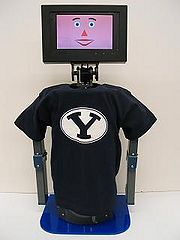Table of Contents
This is a home-grown torso-only humanoid robot, designed and built in the Mechanical Engineering department. The arms of the robot resemble real human arms. The head of the robot is a monitor, so the robot is capable of showing animated expressions (emoticons). The head can also be rotated, so we have the choices of a wide, short head and a thin, tall head.
Research Objectives
- How can a humanoid robot assist in treating children with Autism in clinical settings?
- Can a machine-look-like humanoid robot (loosely resemble a human) help develop autistic children's capabilities in joint attention?
- How can a therapist “program” the robot in preparation for clinical sessions using a skill/behavior based interactive learning interface?
- What interface techniques help the therapists interact with the robot to better treat children with Autism?
Robot Specifications
Sensors
Existing Sensors:
- Visual Sensor: The monitor (head) has webcam built-in. Enables computer vision algorithm to identify patterns.
- Audio Sensor: The monitor (head) has mic built-in. Possibly voice commands.
Possible Sensors:
- Audio Sensor: We could add two mics (as ears) for audio signals detection from different directions.
- Range Sensor: We could add an infrared proximity sensor to detect object distances and trigger events when object is close.
- Position Sensor (wii remotes): Detects locations of the operator's elbows, wrists, etc. The therapist will be holding the wii remotes.
- Motion Sensor (wii remote): Detects the direction of movement from the operator.
Actuators
Existing Actuators:
- Arm movements: Up, down, in, out. 1-DOF elbow and 3-DOF shoulder.
- Head/neck movements: Turn left/right, lean left/right, raise head up/down. 2-DOF neck.
- Display: Monitor (head) can display emotions and expressions.
Possible Actuators:
- Speaker: make sounds or speech
Processor
- Processing is all done on a standalone laptop.
Communication
- Laptop communicates with the robot through a serial cable because USB is too slow.
Robot Skills/Behaviors
Existing skills/behaviors
- Body movements: Arm, head/neck.
Possible skills/behaviors
- Cognitive behaviors: Imitate
- Gestures: Nod, shake heads, wave, YMCA, flux muscles
- Movements: Point at, reach out
- Sounds: Make sounds/noises, speak
- Emotions: Excited (arms up and moving left and right), scared (leaning backward with arms covering face)
- Cognitive behaviors: find face, learn to identify objects, identify direction of sound source
- Social behaviors: Keep gaze on person in front, briefly turn to check out visual/sound changes (curiosity)
Desired skills/behaviors
(Please add here…)


